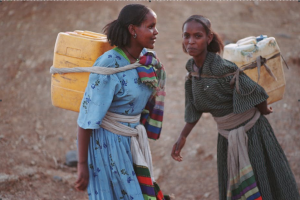
Ethiopian girls carrying water they collected.
Photo Credit: Waterdotorg, CC BY-NC-SA
Water is basic need for all of us. When it is convenient and easy to get we hardly think about it. But for some getting fresh water is a constant thought and burden. Sustainable Development Goal 6 states to, “Ensure availability and sustainable management of water and sanitation for all”. In Ethiopia access to drinking water is improving. It has increased from 13% in 1990 to 53% in 20121. But this still leaves many without convenient and adequate access. Ethiopians are not only struggling for access to water, there also are issues with poor sanitation of water. When drinking water is not clean water borne diseases like diarrhea run rampant and has the greatest affect on children.
So what does this mean for education? It means that children, particularly girls, are spending time collecting water rather than being in school or studying, and children are home sick causing school absences to rise. In Ethiopia it is estimated that 32% of children of primary school age are not attending school2. SDG 4 states, “Ensure inclusive and equitable quality education…for all” and SDG 5, “Achieve gender equality and empower all women and girls”. The Sustainable Development goals regarding access to clean water and improved sanitation go hand in hand in increasing school attendance and equitable education access for girls. As access to water increases the number of secondary school girls in Ethiopia that are able to attend school and be successful in school increases as well.
The Water Walk
Ethiopia is considered “water stressed” by the rapidly growing population and drought. The majority of water being withdrawn is used for agriculture, almost 95%3. For those living in urban areas centralized water sources are more accessible. In rural areas water sources can be great distances away from villages. One study showed that on average those in rural areas walk between 2-5 hours per day to retrieve water (Demie, Beckele, Seyoum, 2016). The lack of access and uncertainty of clean water sources is exasperated by drought and extreme weather events. In Ethiopian culture water gathering, as many household chores, are considered a woman’s responsibility. This means that girls who are able to attend girls are spending time before or after to collect water for their families, affecting their ability to focus in class and taking their studying time. All too often the burden of retrieving water in addition to other responsibilities leads to girls dropping school all together.
Dirty Water
After a girl walks for hours to fetch water for her family it is not always guaranteed that this water will be clean. With the expansion of agriculture to feed a growing population cases of pollution from fields running off into water sources has increased. In addition in some areas the closes fresh water source is also shared by animals. Cases of poor waste management lead to water contamination as well (Demie, 2016). The drinking of this contaminated water leads to the contraction of water-borne illnesses. One of the major hindrances across the globe of children’s ability to attend and stay in school is illness from contaminated water, claiming an estimated 443 million school days each year6. Not only are girls being kept out of school because they are inflicted by water-borne illnesses, but it is also customary for women and girls to care for sick family members. These factors cause girls to be out of school and inevitably out of options.
Washing Up
In response to first the Millennium Development Goals and now the Sustainable Development Goals UNICEF along with multiple NGOs are working to improve water access and sanitation for communities in Ethiopia. These programs have accounted for much of the initial progress that has been made. The UNICEF WASH program works to establish clean water and sanitation infrastructure in addition to supporting the government to reduce water insecurity. There goal is to increase the water access supply to 85% in rural areas and 75% in urban areas by 20207. Individual communities are coming together to improve their individual water access situation as well. These efforts will hopefully be the answer to bringing girls back to the classroom.
Reference
Demie, G., Bekele, M., & Seyoum, B. (2016). Water accessibility impact on girl and women’s participation in education and other development activities: the case of Wuchale and Jidda Woreda, Ethiopia. Environmental Systems Research, 5(1), 11.

